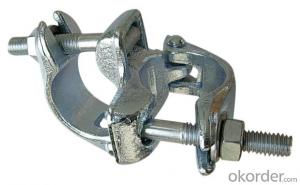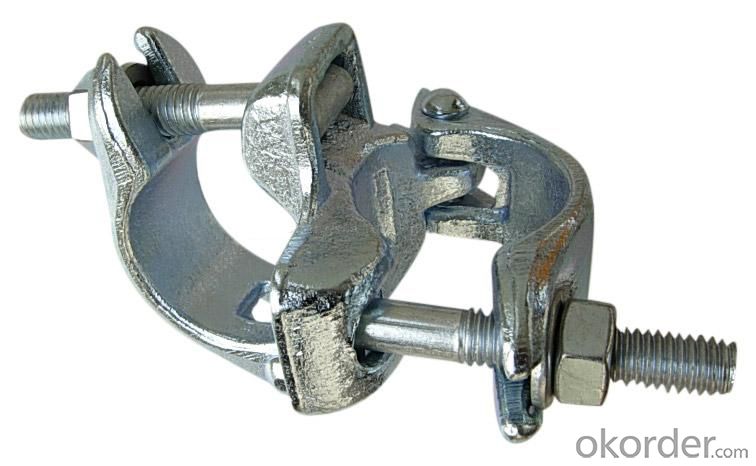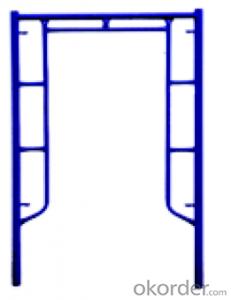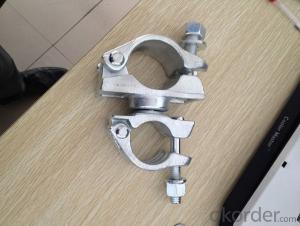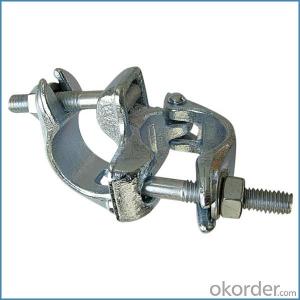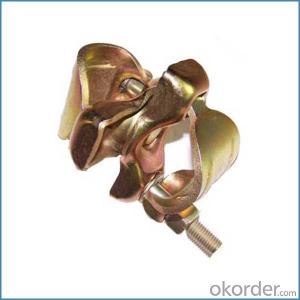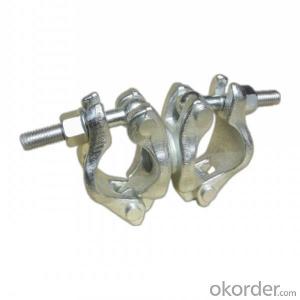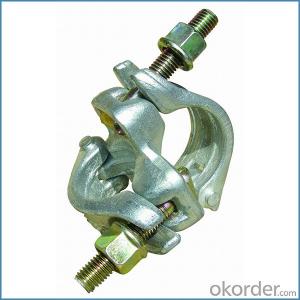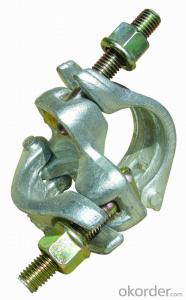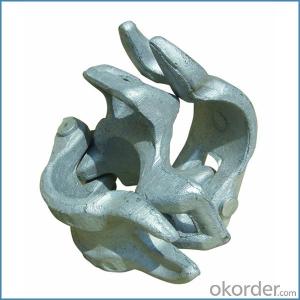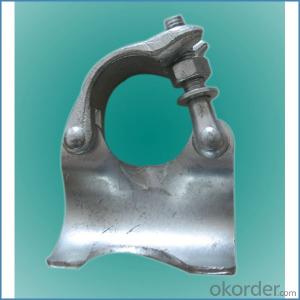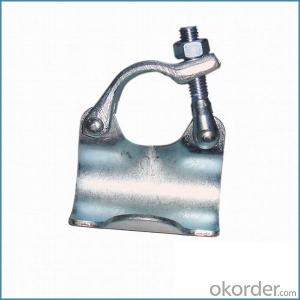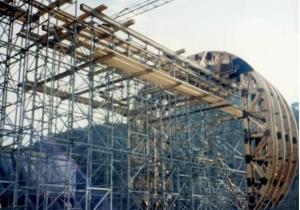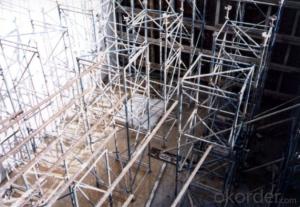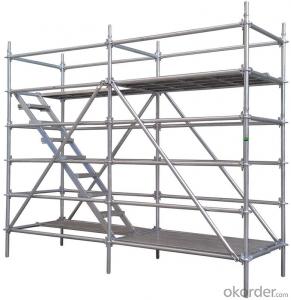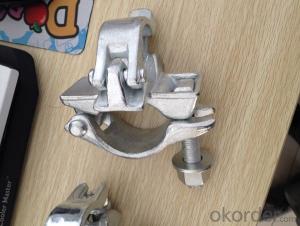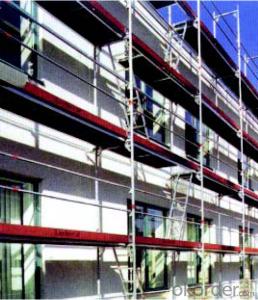Steel Scaffold Clamp Britis German Forged Type
- Loading Port:
- Tianjin
- Payment Terms:
- TT OR LC
- Min Order Qty:
- 1000 kg
- Supply Capability:
- 100000 kg/month
OKorder Service Pledge
OKorder Financial Service
You Might Also Like
Steel Scaffold Clamp Britis German Forged Type
Description
1.The scaffolding coupler is always used to connect the steel pipe as scaffolding system.
2.The often used coupler is swivel coupler and righ angle coupler .
3.We can provide types of scaffolding coupler according to your requirement.
4.Couoler can fix the 48.3mm scaffolding steel pipe tightly and make the whole scaffolding system more steadily.
Feature
(1)Excellent Anti-Breaking—Cold Pressed Steel
(2)Outstanding Resistance Deformation
(3)Strong Anti-Dropping Ability
Photo

Parameter
| Material | Q235,345steel |
| Size | 48.3mm*48.3mm |
| Surface finish | Galvanized |
| Weight | 1.1kg around |
| Standard | BS1139,EN74 |
| Package | 25pcs/bag,steel pallet |
| Manufacture | As per customer requirement |
| Market | Africa, South America, the Middle East and Asia |
FAQ
Q: Are you a factory or trading company?
We are a state-owned corporation in China,dealing with various kinds of building materials.We have our holding subsidiaries.
Q: Where is your factory located? How can I visit there?
Our factory is located all around China.
Q: Can I get some samples?
Sample is free, customer only pay freight for the first time.
Q: Delivery?
10-30days. (5-15 containers)
Any question,feel free to contact us.
- Q: Can steel tube couplers be used to connect different sizes or types of scaffolding tubes?
- Steel tube couplers have the capability to connect scaffolding tubes of varying sizes and types. They are designed to ensure a secure and dependable connection between the tubes, regardless of their size or type. These couplers are specifically manufactured to accommodate different tube diameters, allowing for the connection of tubes with varying sizes, including joining larger diameter tubes with smaller ones or vice versa. Moreover, steel tube couplers possess versatility in connecting tubes made from diverse materials, such as steel, aluminum, or composite materials. This adaptability facilitates the effortless assembly and disassembly of scaffolding structures, making them suitable for a wide range of construction or maintenance projects.
- Q: What is the maximum load capacity of a steel tube coupler?
- The maximum load capacity of a steel tube coupler depends on various factors such as the size and grade of the steel, the design and dimensions of the coupler, and the specific application in which it is used. Steel tube couplers are commonly used in construction and scaffolding systems to connect and support tubes or pipes, providing stability and strength. To determine the maximum load capacity, it is essential to consider the manufacturer's specifications, which typically provide load charts or tables that outline the safe working loads for different sizes and types of couplers. These specifications take into account factors such as the material's yield strength, the safety factors applied, and the load distribution across the coupler. For example, a typical steel tube coupler may have a maximum load capacity ranging from a few hundred kilograms to several tons, depending on its size and design. It is crucial to adhere to these load limits to ensure the safety and integrity of the structure or scaffolding system. It is important to consult the manufacturer's guidelines, engineering calculations, or seek professional advice from structural engineers or scaffolding experts when determining the maximum load capacity of a steel tube coupler for a specific application. This ensures compliance with safety regulations and guarantees the structural stability of the system under the expected loads.
- Q: How do steel tube couplers affect the overall weight of a scaffolding structure?
- Steel tube couplers typically have a minimal impact on the overall weight of a scaffolding structure. This is because couplers are small and lightweight components that are used to connect tubes together, rather than adding significant weight to the structure itself.
- Q: How do steel tube couplers ensure the stability of scaffolding during adverse weather conditions?
- The stability of scaffolding in adverse weather conditions heavily relies on steel tube couplers. These couplers are essential for securely connecting and joining steel tubes, creating a durable structure that can withstand harsh weather elements like strong winds, rain, and snow. To begin with, steel tube couplers are constructed using top-notch steel, ensuring exceptional strength and durability. This enables them to endure the external forces exerted by adverse weather conditions without compromising the stability of the scaffolding. Their robust design prevents deformation or failure under pressure, establishing a solid foundation for the scaffolding system. Moreover, steel tube couplers are engineered with various mechanical features that enhance their resistance to adverse weather conditions. For instance, many couplers incorporate a threaded mechanism that facilitates a tight and secure connection between tubes. This threaded connection effectively eliminates any movement or shifting of the tubes, even when faced with strong winds or heavy rainfall. Additionally, certain couplers are equipped with locking devices or clamps that further reinforce the connection, adding extra stability. Furthermore, steel tube couplers are often galvanized, which involves coating them with a protective layer of zinc. This galvanized coating not only enhances their resistance to corrosion and rust but also provides an additional safeguard against adverse weather conditions. Acting as a barrier, the zinc layer prevents water or moisture from penetrating the couplers and causing any structural damage. In conclusion, steel tube couplers are crucial for maintaining the stability of scaffolding in adverse weather conditions. Their high-quality steel construction, mechanical features, and galvanized coating enable them to withstand external forces, preventing deformation or failure. Thanks to steel tube couplers, scaffolding remains stable and reliable, even when confronted with challenging weather conditions.
- Q: Can steel tube couplers be used for scaffolding structures with uneven ground surfaces?
- Scaffolding structures with uneven ground surfaces can indeed utilize steel tube couplers. The versatility of these couplers enables them to adapt to various angles and positions, thereby facilitating adjustments to counterbalance the unevenness. Moreover, the steel tube couplers' robustness and stability guarantee the security and safety of the scaffolding structure, even in the presence of irregular terrain. To ensure stability and safety in such circumstances, it is crucial to dedicate adequate care and attention to the scaffolding's design and installation.
- Q: Can steel tube couplers be used for angled or curved connections in scaffolding?
- Yes, steel tube couplers can be used for angled or curved connections in scaffolding. They are designed to provide a secure and reliable connection between scaffolding tubes, regardless of the angle or curve.
- Q: Can steel tube couplers be used in both tube and fitting scaffolding systems?
- Steel tube couplers have the ability to be utilized in both tube and fitting scaffolding systems, providing a versatile solution for securely connecting steel tubes. They have been specifically designed to ensure a secure connection and are commonly employed in different types of scaffolding systems, including tube and fitting systems. These couplers play a vital role in joining horizontal, vertical, and diagonal tubes, thereby guaranteeing the stability and structural integrity of the scaffold. Whether it is a tube and fitting system or any other scaffolding system utilizing steel tubes, steel tube couplers offer compatibility and effectiveness.
- Q: How do steel tube couplers perform in areas with high levels of dust or debris?
- Steel tube couplers have been designed to establish a reliable connection between two steel tubes, guaranteeing both structural integrity and load transfer. In environments where dust or debris levels are elevated, the efficiency of steel tube couplers may be moderately affected. The existence of dust or debris has the potential to impede the appropriate engagement of the couplers, resulting in difficulties achieving a tight fit. This, in turn, can compromise the overall strength and stability of the connection, potentially resulting in a weakened structure. Moreover, the accumulation of dust or debris can cause abrasion and wear on the surfaces of the couplers, reducing their lifespan and potentially impacting their performance over time. However, it is important to note that the impact of dust or debris on steel tube couplers can be minimized by implementing suitable measures. The regular cleaning and maintenance of the couplers can help prevent the build-up of dust and debris, ensuring a smooth and secure connection. Additionally, the utilization of protective covers or sealing mechanisms can help safeguard the couplers from external contaminants, thereby prolonging their durability and performance in dusty or debris-filled environments. In conclusion, while steel tube couplers may encounter some challenges in areas with high levels of dust or debris, proper cleaning, maintenance, and the implementation of protective measures can aid in mitigating these issues and guaranteeing their optimal performance.
- Q: Can steel tube couplers be used in scaffolding projects involving cantilevered or projecting platforms?
- Yes, steel tube couplers can be used in scaffolding projects involving cantilevered or projecting platforms. Steel tube couplers are commonly used in scaffolding systems as they provide a secure and reliable connection between tubes, allowing for the construction of various scaffold configurations, including cantilevered or projecting platforms. These couplers ensure the stability and integrity of the scaffolding structure, making them suitable for such projects.
- Q: How do steel tube couplers ensure the levelness and alignment of scaffolding platforms?
- Steel tube couplers are an essential component in ensuring the levelness and alignment of scaffolding platforms. These couplers are designed to securely connect steel tubes together, creating a stable and rigid structure. One way steel tube couplers help maintain the levelness of scaffolding platforms is by providing a strong connection between the tubes. When tubes are joined using couplers, they create a continuous and even support system. This prevents any sagging or tilting of the platform, ensuring its levelness. The rigidity of the steel tubes, combined with the secure connection provided by the couplers, helps distribute the weight evenly across the platform, minimizing any potential unevenness. Furthermore, steel tube couplers play a crucial role in maintaining the alignment of scaffolding platforms. The couplers are designed to fit precisely around the tubes, providing a tight and secure fit. This ensures that the tubes remain in position without any movement or slippage. As a result, the platform maintains its proper alignment throughout its use, preventing any potential shifts or misalignments that could compromise the stability and safety of the scaffolding. In addition to their role in connecting the steel tubes, couplers also allow for easy adjustment and modification of the scaffolding platform. They can be quickly and easily tightened or loosened, enabling workers to level and align the platform as needed. This flexibility ensures that the scaffolding can be adjusted to accommodate uneven terrain or changes in height, guaranteeing a stable and level working surface. Overall, steel tube couplers are an integral part of scaffolding systems, ensuring the levelness and alignment of platforms. By securely connecting steel tubes and providing a rigid structure, these couplers help maintain a stable and safe working environment for workers.
Send your message to us
Steel Scaffold Clamp Britis German Forged Type
- Loading Port:
- Tianjin
- Payment Terms:
- TT OR LC
- Min Order Qty:
- 1000 kg
- Supply Capability:
- 100000 kg/month
OKorder Service Pledge
OKorder Financial Service
Similar products
Hot products
Hot Searches
Related keywords
